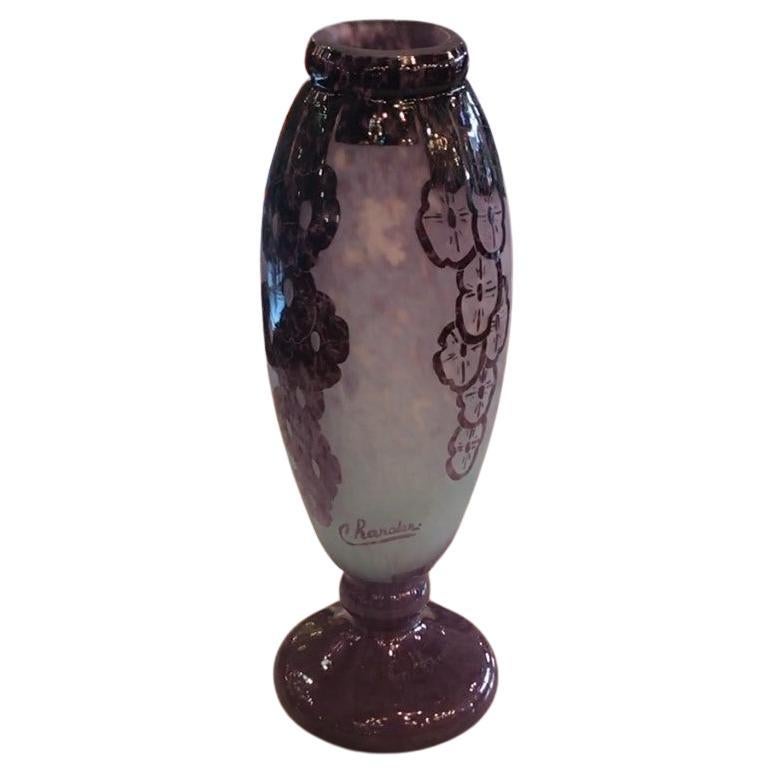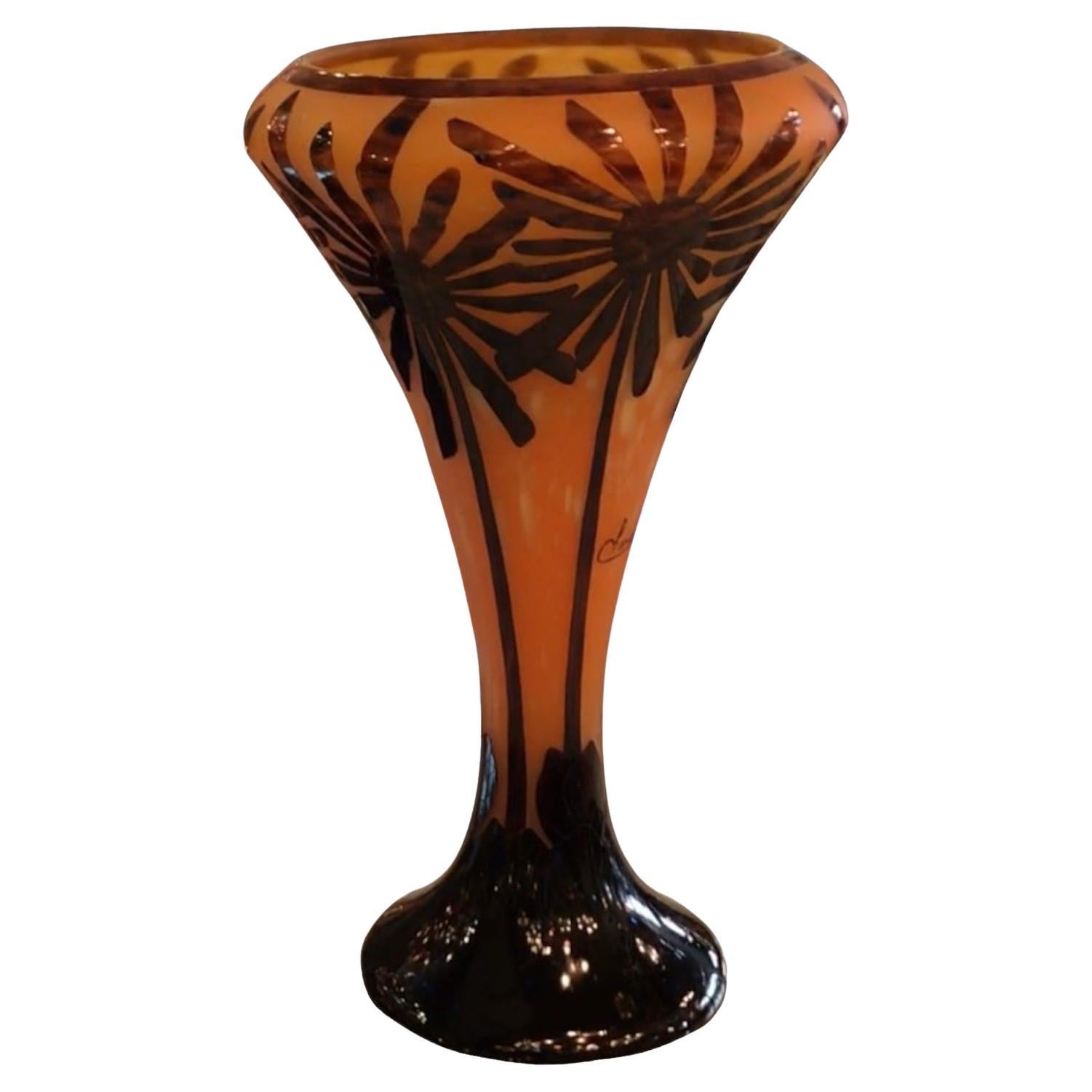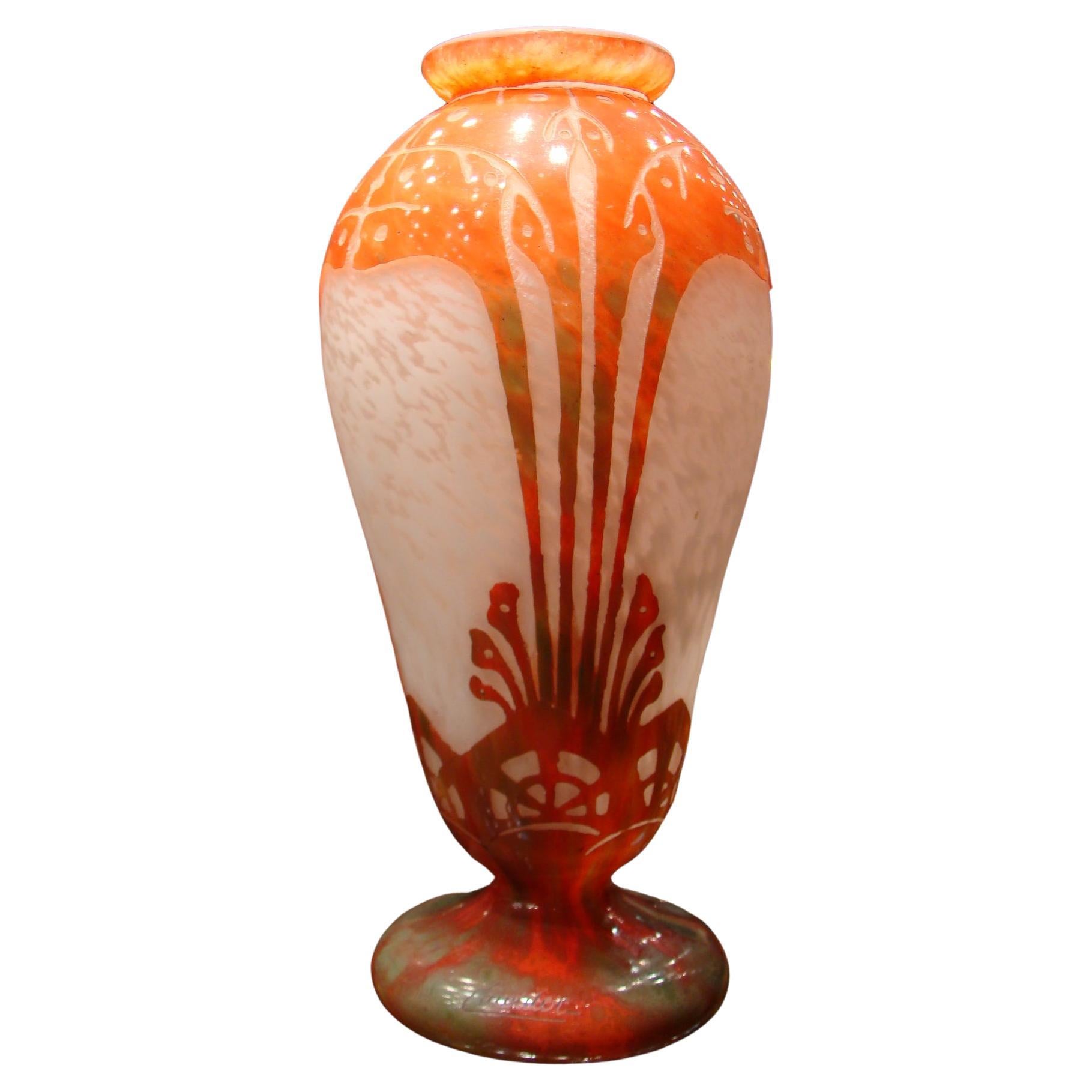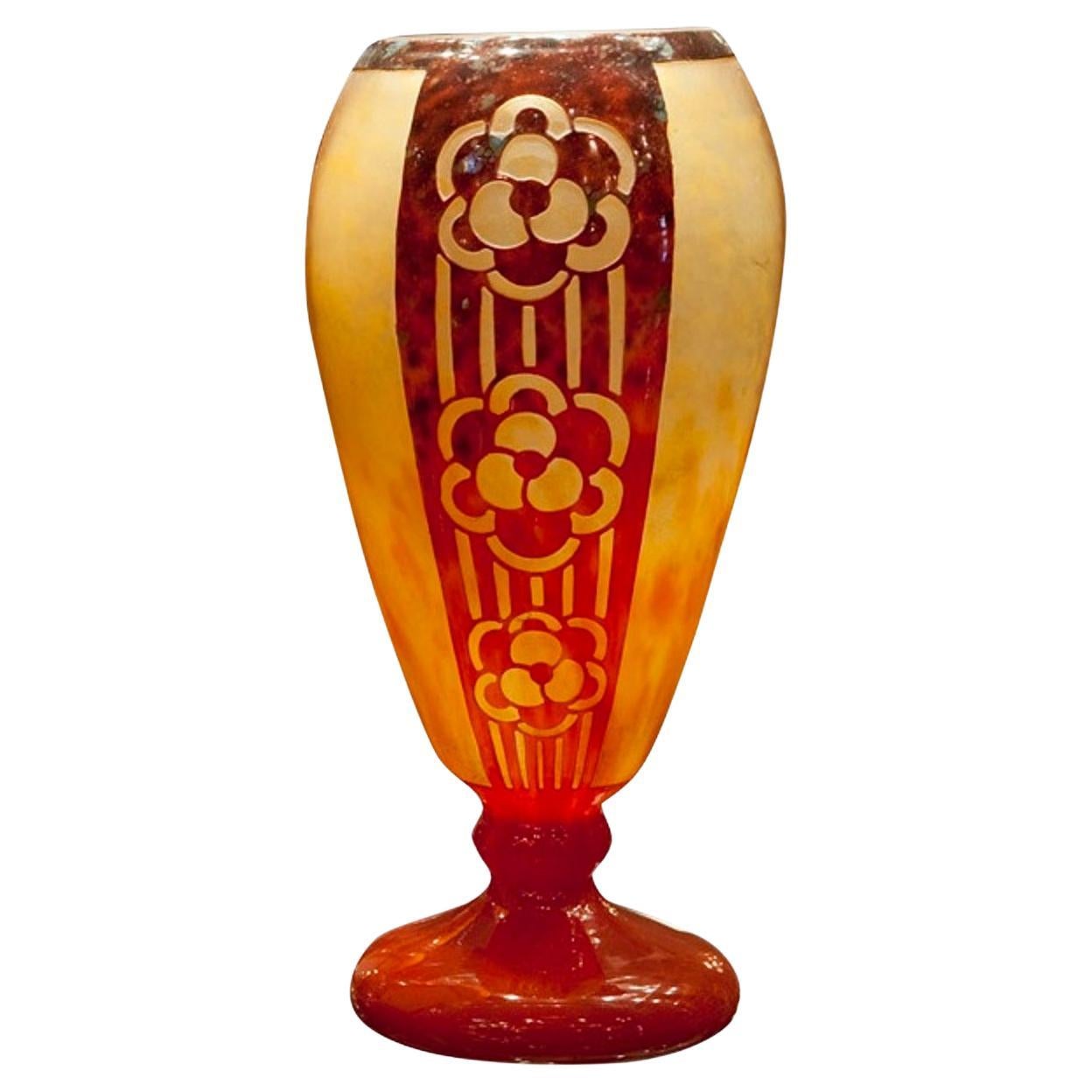Items Similar to Vase, Sign: Charder, Le Verre ( Flowers Peonies ) with application, France, 1927
Video Loading
Want more images or videos?
Request additional images or videos from the seller
1 of 22
Vase, Sign: Charder, Le Verre ( Flowers Peonies ) with application, France, 1927
About the Item
Sign: Charder
CHARDER was a name made up from the first part of Charles and the second part of Schnieder. It was sometimes marked on glass designed by Charles Schneider, particularly pieces in the Le Verre Francais line.
Le Verre Francais was a special line of art glass designs made by the Schneider Glassworks in France between 1918 and 1939. The name was used by the Schneiders for 2 or 3-layered cameo glass vases, bowls, ewers, lamps etc. in a style which combined art deco and art nouveau features.
This line was first introduced in 1918 and was sold in their own retail gallery in Paris, run by their sister Ernestine. Le Verre Francais glass was also sold through major department stores in Paris and in the USA and Europe.
Charles and Ernest Schneider were a generation younger than Emile Galle and the Daum brothers, whose glassworks were in the same area of France. The Schneider brothers worked for Daum from the early 1900s, Ernest as a salesman/commercial manager, and Charles as a freelance designer.
The brothers left Daum around 1912, and recommissioned an old glassworks under the name Schneider Freres et Wolff (Schneider Brothers and Wolff), a few miles north of Paris in 1913. Henri Wolff was an architect friend of Charles Schneider.
Initially they made high quality cameo vases and lamps, but the war in Europe (1914-1918) led Charles and Ernest and most of their skilled glassworkers away to fight in the war. They returned and re-opened their glassworks in 1917 to make glassware needed for hospitals, and after the war they sold shares in the company to finance getting back into the art glass market. At that time the company was called the Societe Anonyme des Verreries Schneider.
Charles Schneider was a brilliant and versatile designer, and the company produced a wide range of superb designs. They were very successful in marketing their glass to major high prestige retail stores both in Paris and overseas. They bought back their shares and re-named the company Verrerie Schneider.
Virtually all their pieces are marked with the name SCHNEIDER or with one of their other trademarks. Sometimes the signature on a Schneider piece was supplemented or replaced by a tiny piece of red, white and blue glass cane set into the glass (a patriotic gesture). If the word "France" appears as part of the Schneider signature, this indicates a piece made for export, and probably made after 1945 at the Cristallerie Schneider.
The depression in the 1930s was a major setback for Schneider's, because their USA market collapsed for them. Their successful but long-drawn-out court case against David Gueron (DEGUE glass) was also a source of hardship for the company in the early 1930s. And their superbly colored glass went out of fashion in France. In 1937 Ernest Schneider died, and in 1939 the company was declared bankrupt and the glassworks sold to a fruit juice company. At the start of the Second War in 1940 the invading German army dumped the contents of the glassworks, destroyed many of their records, and turned it into a brewery.
Cristallerie Schneider was a new glassworks set up by Charles Schneider and his two sons, Charles and Robert, in 1949. Charles Schneider senior died in 1953. The Cristallerie Schneider operated until 1957, when the works was destroyed by an explosion, and during that time they produced some beautiful lines in lead crystal blown glass, often with random internal bubbling.
In 1957/58 Charles Schneider Jr. and his brother Robert Henri built another new glassworks, naming it Verrerie Schneider. They made Schneider Art Glass until 1981 by which time they had both retired and they closed down the company.
We have specialized in the sale of Art Deco and Art Nouveau and Vintage styles since 1982.If you have any questions we are at your disposal.
Pushing the button that reads 'View All From Seller'. And you can see more objects to the style for sale.
Why are there so many antiques in Argentina?
In the 1880 – 1940 there was a grate wave of immigration encouraged by the periods of war that were taking place.
1st World War took place between 1914 and 1918
2nd World War took place between 1939 and 1945
The immigrants options were New York or Buenos Aires. Tickets were cheap and in Buenos Aires they were welcomed with open arms, as it was a country where everything was still to be done.
Argentina was the country of new opportunities, labour was needed and religious freedom was assured, in many cases the of the family travel first until they were settled and then the rest of the family members join them.
In the immigrant museum “Ellis Island Immigrant Building” in New York you can se the promotional posters of the boats that would take them to a new life.
Between the years 1895 and 1896, Argentina had the highest DGP (gross domestic product) per capita in the world according to the Maddison Historical Statistics index, this situation arose due to the large amount of food being exported to European countries, which were at war.
The Argentinean ships left the port of Buenos Aires with food, but they returned with furniture, clothes and construction elements, (it´s common to see this the old buildings of the historic neighbourhood of San Telmo, the beams with the inscription “Made in England)”, as well as many markets that were built in Buenos Aires, such us the San Telmo Market, whose structure was brought by ship and afterwards assembled in 900 Defensa Street.
With the great influence of European immigrants living in the country, the children of the upper classes travelled to study in France, resulting in the inauguration of “La Maison Argentinienne”, on 27th of June 1928, in the international city of Paris, which hosted many Argentinians that were studying in Frace.
It´s the fourth house to be built after France, Canada and Belgium, being the first Spanish-speaking one. Still in place today (17 Bd Jourdan, 75014, Paris, France). Many of the children of these wealthy families who attended international art exhibitions, museums and art courses abroad, took a keen interest in the European style. This is why Buenos Aires was at the time referred as “The Paris of South America”.
Between the years 1890 and 1920 more than a hundred Palaces were built on Alvear Avenue the most exclusive avenue in Buenos Aires. Today some of these palaces have been transformed into museums, hotels and embassies.
In the year 1936, the Kavanagh building was inaugurated, it was the tallest reinforced concrete building in South America.
During 1994 the American Society of Civil Engineers distinguished it as an “international engineering milestone”, and it´s now considered a World Heritage of Modern Architecture.
At the time was common to hire foreign architects such as Le Corbusier, who visited Buenos Aires/Argentina in 1929 and in 1948 he drew up the blueprints for a house built in La Plata City (which was declared a World Heritage Site).
In 1947, the Hungarian architect Marcelo Breuer designed “Parador Ariston” in the seaside city of Mar del Plata. After an Argentinean student at Harvard University convinced him to come to Argentina. He worked on an urban development project in the Casa Amarilla, area of La Boca.
The Ukrainian architect, Vladimiro Acosta, arrives in Argentina in 1928 and worked as an architect until que moved to Brazil.
Antonio Bonet, a Spanish architect who worked with Le Corbusier in Paris, arrives in Argentina in 1937, where he carried out several architectural works and in 1938 designs the well-known BFK chair.
Andres Kálnay, of Hungarian origin, made around 120 architectural masterpieces, among which the former Munich brewery stands out, he even made the furniture’s design.
The German architect, Walter Gropius, director of the Bauhaus, lived in Argentina, where he wrote articles for “Sur” magazine and founded in Buenos Aires, an architectural firm with Franz Möller, who was also an architect, where he built two houses.
At the same time several famous designers decided to immigrate to Argentina, among them we can find the well-known French designer, Jean-Michel Frank, who arrived in the country in 1940 and also worked for the Rockefeller family.
Special pieces were made, which were sold exclusively in the country, such as the well-known German company “WMF”, who sold their products by catalogue, which were chosen by the ladies of High Society in the list of wedding gifts, as well as the pieces designed by Christofle.
The Swiss sculptor Alberto Giacometti, made special pieces for Argentinean mansions.
In 1904 the first Jansen branch outside Paris was established in Buenos Aires, as the Argentinean clientele demanded a large amount of furniture, from the end of the 19th century to the mid-20th century.
In 1970, the brand Rigolleau Argentina made pieces authorised by Lalique.
The brands Maple and Thompson also set up shop in the country.
The French plastic artist, Marcel Duchamp moved to Argentina in 1918-1919.
Glass signed Gallé, Charder, Leverre, Schneider, Muller and other French firms. They were bought in flower shops and were given to ladies with beautiful floral arrangements.
Some furniture manufacturers travelled to international fairs and bough the patterns to produce the furniture in Argentina, such as the furniture firm Englander and Bonta, who bought the patterns ins Italy.
It is worth mentioning that in Argentina we have the largest Community of Italians outside of Italy, as it is estimated that 70 percent of the inhabitants have at least one Italian descendant, followed by Spanish immigrants.
The most Important furniture stores in Argentina:
Comte is founded in 1934 (under the direct management of Jean Michel Frank in 1940).
Nordiska (Swedish company established in 1934).
Churba in 1960, a company that brought foreign designers to present their furniture in the country:
Denmark: (Arne Jacobsen, Finn Juhl, Bender Madsen, Ejner Larsen, Poul Kjaerholm, Hans Wegner)
Sweden: (Hans Agne Jakobsson, Gustavsberg)
United States: (Herman Miller)
Finland: (Lisa Johansson, Folke Arstrom, Tapio Wirkkala, Alvar Aalto, Timo Sarpaneva)
Swedish Factory: (Orrefors)
Italy: (Littala, Vico Magistretti, Emma Gismondi, Gae Aulenti, Angelo Mangiarotti, Elio Martinelli, Gianna Celada, Angelo Mangiarotti, Mario Bellini, Carlo Scarpa)
Finland: (Olivia Toikka)
Plata Lappas (Lappas Silver): a goldsmith shop founded in 1887 in Argentina by Alcibiades Lappas of Greek origin.
In 2019, in Argentina took place “the Art Deco world congress”, in which we participated as hosts invited by Geo Darder, founder of the Copperbridge – Foundation, in which prominent people from all over the world attended to learn about Art Deco in Argentina.
Argentina currently has more than 100 Art Deco buildings and another 90 Art Nouveau buildings throughout the city of Buenos Aires.
Argentina is a country that has not been involved in many wars, which is why it has been a refuge for works of art and antiques from different periods of time, unlike European countries. That is way many collectors, museums and antique dealers from all over the world visit it, you should not miss the opportunity to visit this great country.
Laura Guevara Kjuder, architect.
- Creator:Charder (Designer)
- Dimensions:Height: 19.5 in (49.53 cm)Diameter: 7.5 in (19.05 cm)
- Style:Art Nouveau (Of the Period)
- Materials and Techniques:
- Place of Origin:
- Period:
- Date of Manufacture:1927
- Condition:Wear consistent with age and use.
- Seller Location:Ciudad Autónoma Buenos Aires, AR
- Reference Number:
About the Seller
5.0
Vetted Seller
These experienced sellers undergo a comprehensive evaluation by our team of in-house experts.
Established in 1982
1stDibs seller since 2022
21 sales on 1stDibs
Typical response time: <1 hour
- ShippingRetrieving quote...Ships From: Ciudad Autónoma Buenos Aires, Argentina
- Return PolicyThis item cannot be returned.
More From This SellerView All
- Vase, Sign: Charder, Le Verre Francais ( Eglantines Flowers ), France, 1927By CharderLocated in Ciudad Autónoma Buenos Aires, CSign: Charder, Le Verre Francais CHARDER was a name made up from the first part of Charles and the second part of Schnieder. It was sometimes marked on glass designed by Charles Schn...Category
Vintage 1920s French Art Deco Glass
MaterialsGlass
- Vase, Sign: Charder, Le Verre ( Lavender plant ), France, 1927By CharderLocated in Ciudad Autónoma Buenos Aires, CSign: Charder CHARDER was a name made up from the first part of Charles and the second part of Schnieder. It was sometimes marked on glass designed by Charles Schneider, particularly...Category
Vintage 1920s French Art Deco Glass
MaterialsGlass
- Monumental Vase, Sign: Le Verre Francais, charder ( Decoration Coconut)By Le Verre Francais, CharderLocated in Ciudad Autónoma Buenos Aires, CVase Sign: Le Verre Francais , Charder acid worked Le Verre cameo glass was a separate line of art glass designed by Charles Schneider. Its production was made at the same time as th...Category
Vintage 1920s French Art Nouveau Glass
MaterialsArt Glass
- Vase, Sign: Charder ( Decoration Coconut ), France, 1927By CharderLocated in Ciudad Autónoma Buenos Aires, CSign: Charder CHARDER was a name made up from the first part of Charles and the second part of Schnieder. It was sometimes marked on glass designed by Charles Schneider, particularly...Category
Vintage 1920s French Art Deco Glass
MaterialsGlass
- Vase, Sign: Charder ( Seaweed Decoration ), France, 1927By CharderLocated in Ciudad Autónoma Buenos Aires, CSign: Charder CHARDER was a name made up from the first part of Charles and the second part of Schnieder. It was sometimes marked on glass designed by Charles Schneider, particularly...Category
Vintage 1920s French Art Deco Glass
MaterialsGlass
- Vase, Sign: Charder ( Rosaces Decoration ), France, 1927By CharderLocated in Ciudad Autónoma Buenos Aires, CSign: Charder CHARDER was a name made up from the first part of Charles and the second part of Schnieder. It was sometimes marked on glass designed by Charles Schneider, particularly...Category
Vintage 1920s French Art Deco Glass
MaterialsGlass
You May Also Like
- Charder Art Deco Signed Colorful Etched Glass VaseBy CharderLocated in Studio City, CAA beautifully designed and decorated Charder vase with multi-layered glass and acid-etched detail. Signed "Charder" on body. Will be a gorgeous addition to any setting. Dimension...Category
20th Century French Art Deco Vases
MaterialsArt Glass
- Charder Art Deco French Overlay Glass VaseBy CharderLocated in Autonomous City Buenos Aires, CABACharder Overlay Glass Art Deco glass origin France French cameo glass vase. The Vase is one of the glass vases with this strange and charming long, tall neck shape that I have pers...Category
Vintage 1920s French Art Deco Glass
MaterialsArt Glass, Cut Glass
- Charder Art Deco Signed Etched Colorful Dragonfly Glass VaseBy CharderLocated in Studio City, CAA gorgeously designed and decorated Art Deco glass vase by Charder. The vase has multi-layered glass with acid-etched detail and sits atop a small pedestal base. Signed "Charder" on ...Category
20th Century French Art Deco Vases
MaterialsArt Glass
- Art Deco Glass Vase "Fougeres" by CharderBy CharderLocated in Autonomous City Buenos Aires, CABAFrench art deco cameo glass vase was created by Charles Schneider (1881 – 1953). The vase, in the “Fougeres” cutting depicts geometric ferns in mottled orange, red and green glass ov...Category
20th Century French Art Deco Glass
MaterialsGlass, Art Glass
- Schneider Verre Francais Vase 1927-30By Schneider GlassLocated in Tunbridge Wells, GBHeading : Schneider Verre Francais poppie vase Date : 1927-30 Origin : Epinay-sur-Seine, France Bowl Features : Mottled orange, white, marbled greens, and violets depicting poppies. ...Category
Vintage 1920s French Art Deco Glass
MaterialsArt Glass
- Vase, Le Verre FrancaisBy Le Verre FrancaisLocated in Pompano Beach, FLAn overlaid and etched glass vase, bell flower motif, Le Verre Francais, circa 1930.Category
Vintage 1930s Vases
Recently Viewed
View AllMore Ways To Browse
Religious Leaded Glass
Vintage White Button Down
Charder Lamp
French Glass Vase Bubble
Emile Galle Signatures
Wmf 90
Maison Verre
Vintage Cane Italian Chairs
Sister Lamp
70s High Back Chairs
Vintage Glass Lamps 100 Year Old
Antique Glass And Crystal Lamps
Crystal Vase For Sale
Angelo Mangiarotti Up Up
Hundred Flower Vase
1920s 1930s Italian Objects
Used Bubble Chair
Art Deco Ewers





